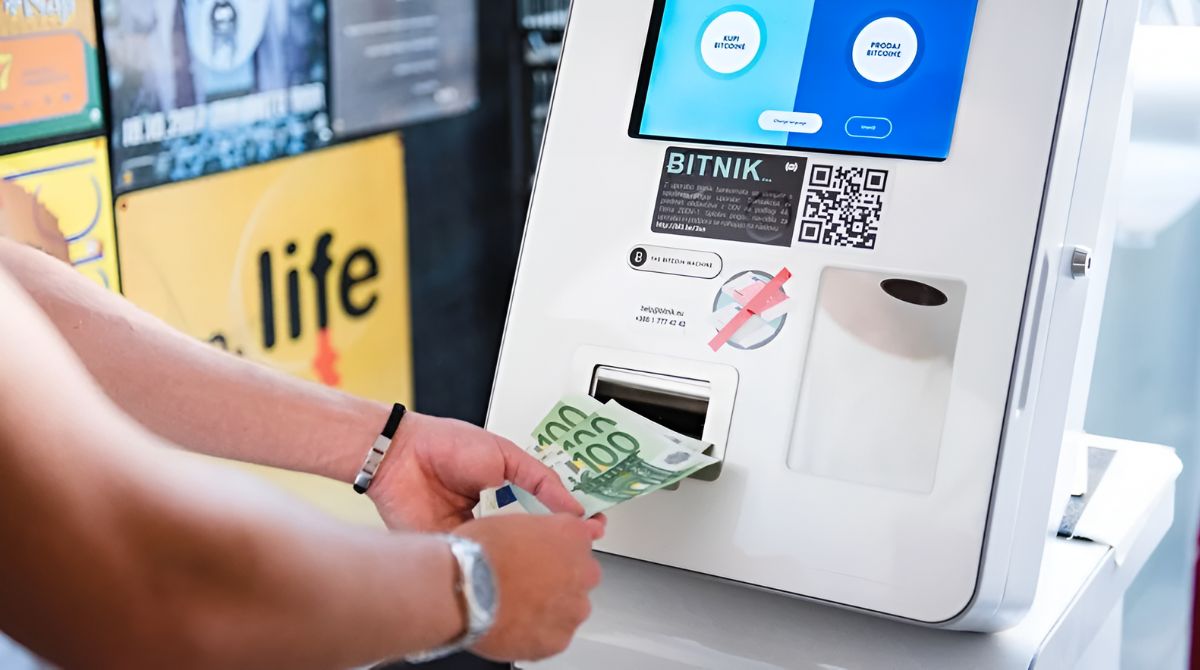Introduction
Welcome to the world of Bitcoin, the revolutionary digital currency that has taken the financial industry by storm. Bitcoin offers a decentralized and secure way to transfer and store value, opening up a wide range of opportunities for individuals to make money.
Bitcoin, often referred to as cryptocurrency, was created by an anonymous person or group known as Satoshi Nakamoto in 2009. Since its inception, Bitcoin has gained popularity and has become increasingly valuable, making it an attractive option for those seeking to make money online.
Unlike traditional fiat currency, such as the US dollar or euro, Bitcoin is not controlled or regulated by any government or financial institution. Instead, it operates on a peer-to-peer network, with transactions recorded on a public ledger called the blockchain.
The decentralized nature of Bitcoin offers several advantages. It allows for greater financial autonomy and privacy, as transactions can be conducted without the need for intermediaries. Additionally, Bitcoin transactions are typically faster and cheaper compared to traditional banking methods, making it an appealing option for international transfers.
Now that you have a basic understanding of Bitcoin, let’s explore some of the ways you can make money using this digital currency. Whether you’re looking to invest, trade, mine, or freelance, there are numerous opportunities to capitalize on the growing popularity of Bitcoin.
Understanding Bitcoin
Before diving into the various ways to make money with Bitcoin, it’s essential to have a solid understanding of how the cryptocurrency works. At its core, Bitcoin is based on a technology called blockchain, which is a distributed ledger that records all transactions made with the currency.
Unlike traditional fiat currencies, Bitcoin is not controlled or regulated by any central authority, such as a government or bank. Instead, it operates on a decentralized network of computers, known as nodes, that validate and verify transactions.
Every Bitcoin transaction is stored on the blockchain, which is a public ledger accessible to anyone. This transparency ensures that all transactions are secure and cannot be altered or tampered with.
Bitcoin is created through a process called mining. Miners use powerful computers to solve complex mathematical problems, and when they successfully solve a puzzle, they are rewarded with newly minted Bitcoin.
One of the key features of Bitcoin is its limited supply. There will only ever be 21 million Bitcoins in existence, with new Bitcoins being created at a decreasing rate over time. This scarcity has contributed to the value of Bitcoin, with many investors considering it a hedge against traditional fiat currencies and inflation.
Bitcoin transactions are conducted using digital wallets, which are software applications that allow users to securely store, send, and receive Bitcoin. These wallets come in various forms, including web-based wallets, mobile wallets, hardware wallets, and paper wallets.
It’s important to note that Bitcoin is highly volatile and its value can fluctuate dramatically. While this volatility can present opportunities for profit, it also carries risks. It’s crucial to approach investing and trading in Bitcoin with caution and to conduct thorough research before making any financial decisions.
Now that you have a basic understanding of how Bitcoin works, let’s explore the different ways you can start making money with this digital currency.
Setting Up a Bitcoin Wallet
Before you can start making money with Bitcoin, you’ll need to set up a Bitcoin wallet. A Bitcoin wallet is a digital wallet that allows you to securely store your Bitcoin and facilitate transactions.
There are various types of Bitcoin wallets available, each offering different levels of security and accessibility.
1. Web-Based Wallets: Web-based wallets are the most convenient option for beginners. They are accessible through a web browser and are typically easy to set up and use. However, these wallets are stored online, which means your Bitcoin is controlled by a third party and may be vulnerable to hacking or theft.
2. Mobile Wallets: Mobile wallets are installed on your smartphone and offer increased convenience. They allow you to carry your Bitcoins with you and make transactions on the go. Mobile wallets are more secure than web-based wallets but are still susceptible to mobile device vulnerabilities.
3. Hardware Wallets: Hardware wallets are physical devices designed to store your Bitcoin offline. They offer the highest level of security as they are not connected to the internet when not in use. Hardware wallets are a great long-term storage solution but may be less convenient for frequent transactions.
4. Paper Wallets: Paper wallets involve printing out your Bitcoin’s public and private keys on a piece of paper and storing it securely. This method provides excellent security as it keeps your Bitcoin completely offline. However, paper wallets can be easily damaged or lost, so it’s crucial to store them in a safe place.
Once you’ve chosen a wallet type, follow the specific instructions provided by the wallet provider to set it up. This typically involves creating a new wallet, generating a unique address, and securing your private keys.
Remember, it’s essential to choose a reputable and trusted wallet provider to ensure the security of your Bitcoin. Research different wallet options and read user reviews before making a decision.
With your Bitcoin wallet set up, you’re now ready to move on to the next step: buying Bitcoin.
Buying Bitcoin
Now that you have a Bitcoin wallet, it’s time to buy some Bitcoin. There are several methods you can use to purchase Bitcoin, depending on your preference and location.
1. Cryptocurrency Exchanges: Cryptocurrency exchanges are online platforms where you can buy, sell, and trade Bitcoin and other cryptocurrencies. These exchanges allow you to exchange fiat currency, such as US dollars or euros, for Bitcoin. Popular exchanges include Coinbase, Binance, and Kraken. To buy Bitcoin on an exchange, you’ll need to create an account, complete the verification process, deposit funds, and place a buy order.
2. Peer-to-Peer (P2P) Trading: Peer-to-peer trading platforms, such as LocalBitcoins and Paxful, connect buyers and sellers directly. These platforms provide a marketplace where users can post buy or sell offers, negotiate the terms, and make transactions. P2P trading offers more privacy and flexibility but requires caution and due diligence to avoid scams or fraudulent sellers.
3. Bitcoin ATMs: Bitcoin ATMs are physical machines that allow you to buy Bitcoin using cash or debit cards. These machines work similarly to regular ATMs, but instead of dispensing cash, they send Bitcoin to your wallet. Bitcoin ATMs are convenient and accessible, especially for those who prefer to use cash for their transactions.
4. Bitcoin Brokers: Bitcoin brokers act as intermediaries between buyers and sellers, allowing you to buy Bitcoin directly from them. These brokers offer a user-friendly interface and typically provide additional services like wallet storage and trading tools. Examples of Bitcoin brokers include eToro and Coinbase Pro.
When buying Bitcoin, it’s essential to consider factors such as fees, payment methods, security measures, and the reputation of the platform or seller. Conduct thorough research and compare different options to find the best solution for your needs.
Once you’ve purchased Bitcoin, it will be transferred to your Bitcoin wallet. Make sure to keep your wallet secure and backup your private keys to prevent any loss of funds.
Now that you own Bitcoin in your wallet, you can explore various ways to make money with this digital currency, ranging from holding it as an investment to actively trading or even mining Bitcoin. The choice is yours!
Holding Bitcoin
One of the simplest ways to make money with Bitcoin is by holding onto it, also known as “HODLing”. This strategy involves buying Bitcoin and holding onto it for the long term, with the expectation that its value will increase over time.
Holding Bitcoin can be compared to investing in any other asset, such as stocks or real estate. The idea is to buy Bitcoin at a certain price and wait for its value to appreciate before selling it for a profit.
The key to successful Bitcoin holding is to understand the market and make informed decisions. While Bitcoin has experienced significant price fluctuations in the past, it has also demonstrated the potential for substantial gains.
When holding Bitcoin, it’s crucial to have a secure and reliable wallet to store your funds. Hardware wallets, such as Ledger or Trezor, offer excellent security and are recommended for long-term storage.
One advantage of holding Bitcoin is that you can participate in potential future price rallies. As the adoption of Bitcoin grows and more people recognize its value, the demand for Bitcoin may increase, leading to a higher price.
However, it’s important to recognize that holding Bitcoin also carries risk. The cryptocurrency market is highly volatile, and prices can fluctuate dramatically. It’s essential to have a long-term perspective and be prepared for potential downturns in the market.
Additionally, it’s essential to keep up with the latest news and developments in the cryptocurrency space. Stay informed about regulatory changes, technological advancements, and market trends that could impact the price of Bitcoin.
Consider dollar-cost averaging as a strategy for holding Bitcoin. This method involves regularly buying a fixed amount of Bitcoin, regardless of its price. By doing this, you can spread out your purchasing and reduce the impact of short-term price fluctuations.
Overall, holding Bitcoin can be a passive way to make money with the potential for significant returns. It requires patience, knowledge, and a long-term perspective. If you believe in the long-term potential of Bitcoin, holding onto it may be a strategy worth considering.
Trading Bitcoin
Another popular way to make money with Bitcoin is through trading. Bitcoin trading involves buying and selling Bitcoin with the goal of making a profit from short-term price fluctuations.
Bitcoin trading can be done on various platforms, including cryptocurrency exchanges and specialized trading platforms. Here are a few key strategies and techniques used in Bitcoin trading:
1. Day Trading: Day trading involves executing multiple trades within a day, taking advantage of small price movements. Traders closely monitor the market and aim to profit from short-term price volatility. This approach requires active monitoring and can be high-risk, as it relies on accurate predictions of short-term market movements.
2. Swing Trading: Swing trading involves holding Bitcoin for a short to medium-term period, typically a few days to weeks, to capture price swings. Traders analyze market trends and use technical analysis tools to identify entry and exit points that maximize profits.
3. Algorithmic Trading: Algorithmic trading involves using automated trading bots or strategies to execute trades based on pre-defined conditions. These algorithms can analyze market data, trends, and indicators to make trading decisions faster and more efficiently than manual trading. Algorithmic trading requires advanced technical knowledge and is often used by experienced traders.
4. Margin Trading: Margin trading allows traders to borrow funds to trade larger amounts of Bitcoin than their available capital. This strategy can increase potential profits but also amplifies potential losses. It’s crucial to understand the risks involved and use proper risk management strategies when engaging in margin trading.
Successful Bitcoin trading requires a solid understanding of technical analysis, chart patterns, and market indicators. Traders often use tools such as candlestick charts, moving averages, and oscillators to analyze price movements and make informed trading decisions.
It’s important to remember that Bitcoin trading carries inherent risks. The cryptocurrency market is highly volatile, and prices can change rapidly. Traders should develop a trading plan, set clear entry and exit points, and always practice risk management.
For beginners, it’s advisable to start with small trades and gain experience before diving into larger trading volumes. Additionally, staying updated with news, market trends, and regulatory developments is crucial for making informed trading decisions.
Trading Bitcoin can be profitable, but it requires discipline, knowledge, and continuous learning. Developing sound trading strategies, managing risk effectively, and staying emotionally detached from trades are key aspects of successful Bitcoin trading.
Mining Bitcoin
Mining Bitcoin is an essential process in the creation and verification of Bitcoin transactions. Miners use specialized hardware and software to solve complex mathematical problems, secure the network, and add new transactions to the blockchain.
When miners successfully solve a mathematical problem, they are rewarded with newly minted Bitcoin, along with transaction fees associated with the transactions they have included in the block. This process ensures the security and integrity of the Bitcoin network.
While in the early days of Bitcoin, mining could be done with standard CPUs, it has now evolved into a highly competitive and specialized industry. Miners now primarily use powerful ASIC (Application-Specific Integrated Circuit) machines, specifically designed for mining Bitcoin.
Here’s a general overview of the mining process:
1. Hardware and Software Setup: Miners need to invest in powerful hardware, such as ASIC machines, to compete in the mining process. They also need mining software that connects their hardware to the Bitcoin network.
2. Joining a Mining Pool: Due to the high level of competition in Bitcoin mining, many miners join mining pools, where they combine their computational power to increase their chances of earning Bitcoin rewards. Mining pools distribute the rewards among the participants based on their contribution.
3. Mining and Solving Blocks: Miners continuously perform calculations to solve mathematical puzzles. Once a miner successfully solves a block, they validate and add it to the blockchain. This process requires substantial computational power and energy consumption.
4. Rewards and Revenue: Miners earn Bitcoin rewards for successfully adding blocks to the blockchain. In addition to the block rewards, miners may also receive transaction fees associated with the transactions in the block. However, it’s important to note that mining profitability depends on factors such as electricity costs, mining difficulty, and Bitcoin’s price.
Mining Bitcoin can be a lucrative venture, but it requires significant upfront investment, ongoing operational costs, and technical knowledge. It’s important to carefully calculate costs and potential profits before getting involved in mining.
Furthermore, the mining industry has become highly competitive, with larger mining operations dominating the network. Mining Bitcoin with a single ASIC machine may not be as profitable as in the past. It’s crucial to stay ahead of the curve and regularly upgrade mining hardware to remain competitive.
Despite the challenges, mining Bitcoin can provide a consistent stream of income for those with access to the necessary resources. It’s important to stay updated on the latest mining hardware, software improvements, and changes in the mining ecosystem to maximize profitability.
Ultimately, mining Bitcoin requires careful consideration of costs, technical expertise, and the ever-changing dynamics of the mining industry.
Staking Bitcoin
Staking Bitcoin is an alternative way to earn income with your Bitcoin holdings, providing an opportunity to earn passive income through the process of validating transactions on a proof-of-stake (PoS) blockchain.
Unlike the traditional mining process used by Bitcoin, which relies on computational power, proof-of-stake blockchains require users to hold a certain amount of cryptocurrency as collateral. This collateral is then used to validate transactions and secure the network.
Here’s how staking Bitcoin typically works:
1. Choose a PoS Blockchain: Look for a blockchain platform that supports staking Bitcoin. Popular options include Ethereum 2.0, Cardano, and Tezos. Make sure to research and understand the specific staking requirements and rewards offered by each platform.
2. Acquire and Hold Bitcoin: To stake Bitcoin, you’ll need to acquire and hold a specific amount of the cryptocurrency. Each blockchain platform sets its own requirements for the minimum amount of Bitcoin needed for staking.
3. Set up a Staking Node or Delegate: Depending on the blockchain platform, you may need to run a staking node or delegate your coins to a staking provider. Running a staking node requires technical expertise, while delegation allows you to participate in staking without the need for specialized hardware and software.
4. Validate Transactions and Earn Rewards: Once your staking setup is complete, your Bitcoin will be used to validate transactions on the blockchain. In return, you will earn staking rewards in the form of additional Bitcoin. The rewards are typically distributed proportional to your stake and the duration of your participation in staking.
Staking Bitcoin offers several advantages compared to traditional mining. It requires less energy consumption and does not require expensive mining hardware. Additionally, staking allows you to continue holding your Bitcoin while earning passive income, without the need to sell or trade your coins.
However, it’s important to consider the risks associated with staking Bitcoin. Since you need to lock up your Bitcoin as collateral, there is a potential risk of losing a portion of your stake if you violate the network’s rules or act maliciously.
Additionally, the rewards and staking conditions can vary between different blockchain platforms. It’s crucial to thoroughly research and assess the platform’s staking parameters, including the annual percentage yield (APY), lock-up periods, and any associated fees.
Staking Bitcoin can be an attractive option for those looking for a passive income stream. It offers the opportunity to earn rewards by participating in the network’s security and consensus mechanism. By carefully selecting a suitable staking platform and understanding the risks involved, you can potentially increase your Bitcoin holdings through staking.
Investing in Bitcoin
Investing in Bitcoin has become increasingly popular as people recognize its potential as a store of value and a hedge against traditional financial systems. Bitcoin’s limited supply and growing adoption have contributed to its increasing value over time, making it an attractive investment opportunity.
Here are some key factors to consider when investing in Bitcoin:
1. Long-Term Potential: Many investors view Bitcoin as a long-term investment opportunity. They believe that as adoption increases and more institutions and individuals embrace Bitcoin, its value will continue to rise. It’s important to consider the overall market trends and the potential for sustained growth over an extended period.
2. Volatility: Bitcoin is known for its volatility, with prices experiencing significant fluctuations. While this volatility can present opportunities for profit, it also carries risks. Investors must be prepared for price swings and have a long-term perspective when investing in Bitcoin.
3. Risk Management: Like any investment, it’s important to establish risk management strategies when investing in Bitcoin. Diversify your investment portfolio, set clear investment goals, and only invest what you can afford to lose. Keep in mind that the value of Bitcoin can be influenced by various factors, including market sentiment, regulatory developments, and economic conditions.
4. Market Research: Conduct thorough research to understand the market factors that influence the price of Bitcoin. Stay updated on news, market trends, and regulatory changes that can impact the cryptocurrency market. Analyze historical price patterns and use technical analysis tools to make informed investment decisions.
5. Storage and Security: Choose a secure Bitcoin wallet to store your investments. Hardware wallets, such as Ledger or Trezor, offer enhanced security by keeping your Bitcoin offline. Implement strong security measures, such as two-factor authentication and secure passwords, to protect your investment from potential hacks or theft.
6. Cost and Timing: Consider the cost and timing of your Bitcoin investments. Buying Bitcoin during a market dip or when the price is relatively low can offer greater potential for returns. However, it’s essential to approach market timing with caution and not rely solely on short-term price fluctuations.
Investing in Bitcoin can be a rewarding venture, but it also carries risks. It’s crucial to approach Bitcoin investments with a clear understanding of its characteristics, market dynamics, and your own risk tolerance. Seek advice from financial professionals if necessary and consider your investment goals and time horizon before allocating funds to Bitcoin.
Accepting Bitcoin as Payment
Accepting Bitcoin as payment can be an excellent way to diversify your business and tap into a growing market of cryptocurrency users. Bitcoin offers several advantages for merchants, including lower transaction fees, faster international payments, and increased customer privacy.
Here are some key considerations when accepting Bitcoin as payment:
1. Set Up a Bitcoin Wallet: To accept Bitcoin, you’ll need to set up a Bitcoin wallet for your business. There are various types of wallets available, including web-based wallets, mobile wallets, hardware wallets, and payment processor wallets. Choose a secure and user-friendly wallet that suits your needs.
2. Display Your Bitcoin Payment Option: Make sure to prominently display that you accept Bitcoin as a payment option. This can be done by adding a “Bitcoin Accepted Here” logo or a QR code on your website, physical store, or invoices. Customers need to be aware that they can pay with Bitcoin when doing business with you.
3. Transaction Confirmation: Once a customer pays with Bitcoin, it’s important to wait for transaction confirmations before considering the payment complete. Depending on the Bitcoin network’s congestion, this process can take a few minutes to an hour. Most wallets and payment processors provide notifications when a transaction is confirmed.
4. Price Volatility: Bitcoin’s price can experience significant fluctuations. Consider whether you want to lock the price at the time of the transaction or convert the Bitcoin payment into your preferred fiat currency immediately. Payment processors can provide options for immediate conversion to mitigate the risk of price volatility.
5. Secure Your Bitcoin Payments: Implement strong security measures to protect your Bitcoin payments against potential hacks or thefts. Use a secure wallet, enable two-factor authentication, and regularly update your systems and software. Educate your employees on best practices for handling Bitcoin transactions securely.
6. Inform Customers about the Payment Process: Ensure that your customers understand the payment process when using Bitcoin. Provide clear instructions on how to send Bitcoin payments, including the wallet address or the use of QR codes. Consider offering customer support to address any concerns or questions your customers may have.
7. Accounting and Tax Considerations: Keep track of your Bitcoin transactions for accounting and tax purposes. Consult with a professional accountant or tax advisor to understand the reporting requirements and tax implications of accepting Bitcoin as payment in your jurisdiction.
By accepting Bitcoin as payment, you can expand your customer base, attract cryptocurrency enthusiasts, and differentiate yourself from competitors. It’s important to stay updated on the latest developments in Bitcoin technology, payment processors, and regulatory requirements to ensure a smooth and secure payment process for your customers.
Automated Bitcoin Trading
Automated Bitcoin trading, also known as algorithmic trading, involves using computer programs or bots to automatically execute trades based on predefined strategies, indicators, and market conditions. This form of trading leverages technology to take advantage of quick and accurate decision-making capabilities.
Here are some key aspects to consider in automated Bitcoin trading:
1. Trading Bots: Trading bots are computer programs that can execute trades on your behalf. These bots are designed to analyze market data, identify patterns, and execute trades based on predefined rules and algorithms. They can monitor multiple exchanges simultaneously, making it easier to spot potential trading opportunities.
2. Strategy Development: Whether you use a pre-existing trading strategy or create your own, it’s essential to have a clear set of rules and predefined conditions for trading. These rules can be based on technical indicators, market trends, or other specific criteria. Backtesting your strategy using historical data can help assess its performance before deploying it in real-time trading.
3. Market Data Analysis: Automated trading relies heavily on real-time market data. Trading bots can be configured to gather and analyze various market indicators, such as price movements, trading volumes, and order book data. By processing and interpreting this data, bots can make informed trading decisions more efficiently than human traders.
4. Risk Management: Implementing proper risk management strategies is crucial in automated Bitcoin trading. As with any form of trading, risks exist, such as market volatility and the potential for technical glitches. Setting stop-loss orders, defining risk tolerance levels, and continuously monitoring your trading bot’s performance are essential steps to mitigate risks.
5. Continuous Monitoring: While automated trading can operate 24/7, it’s essential to monitor the performance of your trading bot regularly. This includes assessing the execution of trades, adjusting strategy parameters when necessary, and keeping track of overall profitability. Be prepared to make manual interventions or updates to your bot’s settings if market conditions require it.
6. Market Conditions: Automated trading can be highly influenced by market conditions, including news events, regulatory changes, and market sentiment. Stay updated on the latest developments in the Bitcoin and cryptocurrency markets to adjust your trading strategies accordingly. This could involve temporarily disabling or modifying your trading bot’s parameters to adapt to shifting market dynamics.
7. Considerations and Risks: While automated trading can be lucrative, it also comes with risks. Technical glitches, connectivity issues, or poorly optimized strategies can result in financial losses. Additionally, automated trading requires a certain level of technical knowledge, and it’s important to thoroughly research and test any trading bot or platform before using it with real funds.
Automated Bitcoin trading can provide opportunities for traders to execute trades quickly and efficiently, taking advantage of market movements and trends. However, it requires careful planning, constant monitoring, and thorough understanding of the risks involved. Utilizing the right tools and strategies can increase the potential for success in automated Bitcoin trading.
Bitcoin Freelancing
Bitcoin freelancing refers to providing goods or services to clients and receiving payment in Bitcoin. This form of freelancing has gained popularity as the use of cryptocurrencies, including Bitcoin, has increased. It offers several advantages for both freelancers and clients.
Here are some key aspects to consider in Bitcoin freelancing:
1. Global Reach: Bitcoin freelancing allows you to work with clients from around the world. Since Bitcoin transactions are not restricted by traditional banking systems or geographical boundaries, you can tap into a global market of potential clients.
2. Lower Transaction Fees: Traditional payment methods often incur high transaction fees, especially for cross-border transactions. Bitcoin transactions typically have lower fees, making it an attractive option for freelancers receiving international payments.
3. Faster Payments: Bitcoin transactions are usually faster compared to traditional banking systems, especially for international transfers. Freelancers can receive their payments quickly, enabling them to access their funds and start new projects sooner.
4. Increased Privacy: Bitcoin transactions provide a certain level of privacy, as they do not require personal identification details. This can be beneficial for freelancers who value their privacy or work in industries where privacy is crucial.
5. Security: Bitcoin transactions are secured through cryptographic protocols, making them highly secure. Freelancers can have peace of mind knowing that their payments are protected from fraud or unauthorized access.
6. Portfolio Development: By accepting Bitcoin payments, freelancers can expand their portfolio and gain experience in the cryptocurrency industry. This can open doors to new opportunities and attract clients who specifically seek freelancers with Bitcoin expertise.
7. Marketplaces and Platforms: There are several Bitcoin freelance marketplaces and platforms where freelancers can advertise their services and connect with potential clients. Websites like Bitwage, XBTFreelancer, and Crypto Jobs List cater specifically to Bitcoin freelancers.
When freelancing with Bitcoin, it’s important to consider a few factors. Stay updated on the latest Bitcoin exchange rates and convert your earnings into a fiat currency if needed to manage your expenses. Additionally, take into account the potential tax implications of receiving income in Bitcoin and consult with a professional accountant or tax advisor.
Bitcoin freelancing offers an alternative and flexible way for freelancers to receive payments and tap into the growing cryptocurrency economy. Freelancers who embrace Bitcoin can position themselves as early adopters in this emerging market, potentially benefiting from its future growth and opportunities.
Peer-to-Peer Bitcoin Lending
Peer-to-peer (P2P) Bitcoin lending has emerged as a way for individuals to lend and borrow Bitcoin directly from one another, without the need for intermediaries such as banks or financial institutions. This lending method offers benefits for both lenders and borrowers in the Bitcoin ecosystem.
Here are some key aspects to consider in peer-to-peer Bitcoin lending:
1. Direct Borrowing and Lending: P2P Bitcoin lending allows individuals to borrow Bitcoin directly from lenders without the involvement of traditional financial intermediaries. Borrowers can access funds more quickly and with fewer restrictions compared to traditional lending methods.
2. Increased Access to Capital: P2P Bitcoin lending enables borrowers to access capital without the need for extensive credit histories or collateral. This can be particularly beneficial for individuals who may face challenges obtaining loans from traditional financial institutions.
3. Interest Rates: Lenders in P2P Bitcoin lending can earn interest on their Bitcoin holdings by lending them to borrowers. The interest rates are typically determined by the supply and demand dynamics within the lending platform. This allows lenders to potentially earn passive income from their Bitcoin holdings.
4. Reduced Transaction Costs: P2P Bitcoin lending platforms often have lower transaction costs compared to traditional banking systems. The absence of intermediaries and the peer-to-peer nature of the lending process contribute to lower operational costs, resulting in more favorable terms for borrowers and lenders.
5. Risk Management: When participating in P2P Bitcoin lending, it’s crucial to assess the risk associated with borrowers. Platforms often provide borrower profiles, credit ratings, and details about their borrowing history to help lenders make informed decisions. Diversifying the lending portfolio across multiple borrowers can also help mitigate risk.
6. Smart Contracts and Escrow: Many P2P lending platforms utilize smart contracts, which enable transparent and automated agreement enforcement. Smart contracts establish lending terms, repayment schedules, and interest rates. Additionally, escrow services can be utilized to hold the borrowers’ collateral until the loan is repaid.
7. Platform Selection: There are various P2P Bitcoin lending platforms available, each with its own features, terms, and borrower profiles. It’s essential to research and choose a reputable platform that aligns with your lending preferences and risk tolerance.
When engaging in P2P Bitcoin lending, it’s important to clearly define lending terms, including loan amounts, interest rates, and repayment schedules. Additionally, borrowers should assess their ability to repay the loan on time and understand the potential risks associated with Bitcoin’s price volatility.
Peer-to-peer Bitcoin lending provides individuals with a decentralized and accessible way to access capital and earn interest on their Bitcoin holdings. It promotes financial inclusion and empowers borrowers and lenders alike in the Bitcoin ecosystem.
Bitcoin Faucets and Microtasks
Bitcoin faucets and microtasks provide a way for individuals to earn small amounts of Bitcoin by completing simple online tasks. These tasks can range from watching advertisements, completing surveys, playing games, or solving captchas. Although the payouts are relatively small, these methods can be a fun and accessible way for newcomers to earn their first Bitcoin.
Here are some key aspects to consider in Bitcoin faucets and microtasks:
1. Bitcoin Faucets: Bitcoin faucets are websites or apps that reward users with small amounts of Bitcoin for completing simple tasks or solving captchas. Faucets typically distribute the Bitcoin periodically, often based on a timer or specific action thresholds. Rewards from faucets are generally small due to the minimal effort required to complete the tasks.
2. Microtasks: Microtask platforms connect individuals who are willing to perform small tasks with those who need them done. This can include tasks such as data entry, content moderation, or online research. Users can earn Bitcoin by completing these tasks, with payment usually based on the complexity and time required to complete each microtask.
3. Low Entry Barrier: Bitcoin faucets and microtasks have a low entry barrier, making them accessible to anyone with an internet connection. Users don’t need to possess advanced technical skills or make significant investments to participate. It’s a straightforward way to get acquainted with Bitcoin and experience its use in a practical context.
4. Time and Effort: While Bitcoin faucets and microtasks can provide a steady flow of small amounts of Bitcoin, they require consistent effort and time to accumulate significant earnings. The tasks involved are typically simple and can be completed during spare time, but the returns per task are relatively low.
5. Risk of Scams: As with any online activity, it’s crucial to be cautious of scams in the Bitcoin faucet and microtask space. Ensure you use reputable platforms and avoid sharing personal or sensitive information unnecessarily. Exercise due diligence and read user reviews and feedback to gauge the reliability and trustworthiness of a particular platform.
6. Explore Multiple Platforms: There are numerous Bitcoin faucet and microtask platforms available, each with its own set of tasks and reward structures. Exploring multiple platforms allows you to diversify your earning potential and find the tasks that align with your interests and skills.
Bitcoin faucets and microtasks provide a way for individuals to earn small amounts of Bitcoin while learning about its functionalities and use. While they may not result in substantial earnings, they offer an accessible entry point for those curious about the world of Bitcoin and cryptocurrency.
It’s important to manage your expectations and view Bitcoin faucets and microtasks as a way to gradually accumulate Bitcoin rather than a primary source of income. Additionally, continue to educate yourself about Bitcoin, blockchain technology, and the various opportunities available to make the most of your Bitcoin earnings.
Bitcoin Affiliate Marketing
Bitcoin affiliate marketing is a popular approach that allows individuals to earn Bitcoin by promoting and referring others to Bitcoin-related products, services, or platforms. This form of marketing leverages the reach and influence of affiliates to drive traffic and generate conversions, earning a commission in Bitcoin for successful referrals.
Here are some key aspects to consider in Bitcoin affiliate marketing:
1. Affiliate Programs: Bitcoin-related businesses or platforms often offer affiliate programs to incentivize individuals to promote their products or services. These programs provide affiliates with unique referral links or promo codes to track their referrals and attribute commissions accurately.
2. Commission Structures: Affiliates earn commissions based on a predetermined agreement with the merchant or platform. Commissions can be structured as a percentage of the value of referred transactions, a fixed amount per referral, or a combination of both. It’s important to understand the commission structure and any conditions or limitations associated with earning commissions.
3. Promotion Channels: Successful Bitcoin affiliate marketing requires reaching a relevant audience. Affiliates can leverage various channels such as blogs, social media platforms, email marketing, YouTube channels, or dedicated websites to promote their affiliate links. It’s important to choose channels that align with the target audience’s interests and preferences.
4. Content Creation: Creating compelling and informative content is essential to attract and engage potential referrals. Quality content can include reviews, tutorials, educational resources, or comparisons of Bitcoin-related products or services. The goal is to provide valuable information and build trust with the audience to increase the likelihood of conversions.
5. Disclosure and Transparency: It’s crucial for affiliates to disclose their relationship with the affiliate programs they promote to maintain transparency and comply with legal requirements. Clearly disclosing that content contains affiliate links or that affiliate partnerships exist helps maintain trust and integrity with the audience.
6. Tracking and Analytics: Utilizing tracking tools and analytics is crucial to measure the performance of your affiliate marketing efforts. These tools can provide valuable insights into the success of your promotional activities, allowing you to optimize your strategy and focus on channels and programs that yield the best results.
7. Industry Updates and Networks: Stay up-to-date with the latest developments in the Bitcoin industry and affiliate marketing networks. Joining relevant industry communities and networks can provide valuable insights, updates on new programs, and opportunities to connect with like-minded individuals.
Bitcoin affiliate marketing offers individuals the opportunity to earn Bitcoin through their promotional efforts. It can be a flexible and scalable income stream, allowing affiliates to leverage their existing audience and expand their reach within the Bitcoin ecosystem.
Remember to choose reputable affiliate programs, understand the terms and conditions, and prioritize building trust with your audience. By providing genuine and valuable information, you can effectively promote Bitcoin-related products or services and earn Bitcoin as a result.
Bitcoin Advertising Networks
Bitcoin advertising networks serve as platforms that connect advertisers with website owners or content creators who are willing to display Bitcoin-related ads on their platforms. These networks allow advertisers to reach a targeted audience interested in Bitcoin and blockchain-related products or services. They provide an effective marketing channel within the cryptocurrency ecosystem.
Here are some key aspects to consider in Bitcoin advertising networks:
1. Targeted Advertising: Bitcoin advertising networks specialize in connecting advertisers with a specific audience interested in Bitcoin and cryptocurrencies. This targeted approach ensures that ads reach relevant users who are more likely to engage with the advertised products or services.
2. Ad Formats: Bitcoin advertising networks offer various ad formats, including display ads, native ads, pop-up ads, or sponsored content. Each format has its own advantages and may be more suitable for specific types of products or services. Advertisers can choose the format that best aligns with their marketing goals.
3. Audience Reach: Bitcoin advertising networks often have a wide reach and access to a large network of websites and content creators. This allows advertisers to tap into a broad audience interested in Bitcoin, cryptocurrencies, blockchain technology, or related topics.
4. Bidding Systems: Many Bitcoin advertising networks utilize a bidding system, where advertisers can compete for ad placement by bidding on available inventory. The higher the bid, the higher the chances of securing premium ad spots. Advertisers can manage their budgets and optimize their bids to achieve the desired positioning and maximize exposure.
5. Performance Tracking: Bitcoin advertising networks provide comprehensive analytics and reporting tools, allowing advertisers to track the performance of their ad campaigns. These tools provide valuable insights into impressions, click-through rates, conversions, and other key metrics, enabling advertisers to optimize their campaigns for better results.
6. Ad Quality: Reputable Bitcoin advertising networks prioritize ad quality and relevance. They often have guidelines and policies to ensure that the displayed ads are legitimate, non-invasive, and align with industry standards. This helps maintain a positive user experience and credibility within the Bitcoin advertising ecosystem.
7. Ad Blocking and Compliance: Bitcoin advertising networks face challenges related to ad blocking software and compliance with regulations. They employ various techniques and technologies to mitigate the impact of ad blockers and ensure compliance with privacy laws and regulations.
Bitcoin advertising networks offer a valuable marketing channel for businesses and organizations within the cryptocurrency industry. By targeting a specific audience interested in Bitcoin, these networks can help advertisers increase their brand visibility, attract new customers, and raise awareness about their Bitcoin-related products or services.
When choosing a Bitcoin advertising network, consider factors such as audience reach, ad formats, targeting capabilities, reputation, and available analytics. By carefully selecting the right network and optimizing your ad campaigns, you can effectively leverage Bitcoin advertising networks to drive targeted traffic and achieve your marketing objectives.
Bitcoin Escrow Services
Bitcoin escrow services play a crucial role in facilitating secure transactions within the cryptocurrency ecosystem. Escrow services act as intermediaries, holding funds or assets in a secure manner until predetermined conditions are met. This provides assurance to both buyers and sellers involved in Bitcoin transactions.
Here are some key aspects to consider in Bitcoin escrow services:
1. Transaction Protection: Bitcoin escrow services offer protection to both buyers and sellers by ensuring that funds or assets are held securely until all conditions of the transaction are met. This reduces the risk of dishonesty or non-compliance from either party involved.
2. Dispute Resolution: Escrow services often provide dispute resolution mechanisms to address conflicts or disagreements that may arise during a transaction. If disputes occur, the escrow service can mediate and facilitate a fair resolution based on the agreed-upon terms.
3. Secure Holding: Bitcoin escrow services securely hold the funds or assets in a designated account until the completion of the transaction. This eliminates the need for trust between transacting parties and minimizes the risk of fraud or theft.
4. Multi-Signature Wallets: Bitcoin escrow services typically utilize multi-signature wallets to enhance security. In a multi-signature setup, multiple private keys are required to access the funds, ensuring that no single party can unilaterally control the assets.
5. Transaction Flexibility: Bitcoin escrow services offer flexibility in setting up escrow transactions. Parties can define the terms and conditions of the escrow, including release conditions, delivery verification, and any other specific requirements relevant to their transaction.
6. Trust and Reputation: It’s important to choose reputable and trusted Bitcoin escrow services to ensure the integrity of the transaction and the protection of funds or assets. Research the reputation and track record of the escrow service, and consider reading user reviews and testimonials before engaging their services.
7. Types of Transactions: Bitcoin escrow services are commonly used for various types of transactions, including peer-to-peer trades, online marketplace transactions, large-scale purchases, or cryptocurrency-based contracts. They provide security for a wide range of transactions and instill confidence in both buyers and sellers.
Bitcoin escrow services play a crucial role in reducing risks and building trust between parties involved in Bitcoin transactions. They ensure that funds or assets are securely held until all conditions are met, providing peace of mind and increasing the efficiency and credibility of Bitcoin-based transactions.
When considering Bitcoin escrow services, evaluate their security measures, dispute resolution policies, fees, and customer support. Choosing the right escrow service is essential to ensure a smooth and secure transaction process within the Bitcoin ecosystem.
Bitcoin Gambling and Online Casinos
Bitcoin gambling and online casinos have revolutionized the gambling industry by integrating cryptocurrency as a transparent and secure method for betting and playing games. Bitcoin gambling offers several advantages, including anonymity, faster transactions, and lower fees, making it an attractive option for players worldwide.
Here are some key aspects to consider in Bitcoin gambling and online casinos:
1. Privacy and Anonymity: Bitcoin transactions provide a certain level of privacy as they don’t require personal identification details. This makes Bitcoin gambling appealing to individuals who prioritize their privacy online.
2. Fast Transactions: Bitcoin transactions are typically faster than traditional banking methods. Deposits and withdrawals can be processed within minutes, allowing players to swiftly access their funds.
3. Lower Fees: Bitcoin transactions often involve lower fees compared to traditional payment methods. This means that players can retain more of their winnings, as casinos charge smaller transaction fees.
4. Provably Fair Gaming: Many Bitcoin gambling platforms use provably fair algorithms to ensure fairness in games. These algorithms allow players to verify the integrity and randomness of game outcomes, promoting transparency and trust in the gambling process.
5. Wide Variety of Games: Bitcoin gambling platforms offer a wide assortment of games, ranging from classic casino games like blackjack, roulette, and slots to niche options including dice, poker, and sports betting. Players have a diverse selection to choose from, catering to their individual preferences.
6. Regulation and Licensing: While the Bitcoin gambling industry continues to evolve, it’s important to select licensed and regulated casinos to ensure a safe and secure gaming experience. Look for platforms that hold reputable gambling licenses and are audited for fairness and security standards.
7. Exchange Rate Risk: Bitcoin’s value can be highly volatile, which introduces exchange rate risk in Bitcoin gambling. Players should consider the potential impact of fluctuating exchange rates when converting their Bitcoin winnings into fiat currency.
As with any type of gambling, responsible gambling practices should be followed when engaging in Bitcoin gambling and online casinos. Setting limits on deposits and losses, taking breaks, and recognizing potential signs of addictive behavior are essential to maintain a healthy gambling experience.
Bitcoin gambling and online casinos have reshaped the gambling industry, providing players with an innovative and secure way to bet and play games. With the advantages of Bitcoin’s fast transactions, lower fees, and provable fairness, Bitcoin gambling continues to gain popularity among gamblers seeking a unique and enhanced gaming experience.
Donations in Bitcoin
Donating in Bitcoin has emerged as a popular method for individuals and organizations to support causes they care about. Bitcoin donations offer benefits such as increased transparency, lower transaction fees, and broader accessibility. By leveraging the power of cryptocurrency, Bitcoin allows donors to make a positive impact through their contributions.
Here are some key aspects to consider in Bitcoin donations:
1. Transparency: Bitcoin donations are recorded on a public ledger called the blockchain. This ensures transparency and enables donors and recipients to track the flow of funds in real-time. The public nature of transactions helps build trust and accountability.
2. Lower Transaction Fees: Bitcoin donations generally involve lower transaction fees compared to traditional payment methods. This means that more of the donated funds can be directed towards the intended cause, maximizing the impact of each donation.
3. Global Accessibility: Bitcoin donations provide global accessibility, allowing individuals from anywhere in the world to contribute to organizations and causes. This is particularly beneficial for cross-border donations, as it eliminates the complexities and costs associated with international transactions.
4. Nonprofit Acceptance: Many nonprofit organizations and charitable foundations now accept Bitcoin donations. These organizations provide clear instructions and addresses for accepting donations in Bitcoin, making it convenient for donors to contribute to their chosen causes using cryptocurrency.
5. Donor Anonymity: Bitcoin donations can offer a certain level of donor anonymity. While Bitcoin transactions are recorded on the blockchain, the identity of the donors can be protected if they choose to remain anonymous. This can be appealing for individuals who value their privacy or wish to contribute without revealing personal information.
6. Giving Back to the Bitcoin Community: Bitcoin donations can also involve giving back to the Bitcoin community itself. Contributions to open-source projects, blockchain research initiatives, or Bitcoin development efforts help support the growth and innovation of the cryptocurrency ecosystem.
7. Volatility Management: Bitcoin’s price can be subject to significant fluctuations. Nonprofit organizations that accept Bitcoin donations may choose to convert the received Bitcoin into fiat currency immediately to mitigate the risk of price volatility. This ensures that the value of the donations remains stable and predictable.
Donating in Bitcoin offers a modern and impactful way to support causes and organizations. By embracing the transparency, lower fees, and accessibility of Bitcoin, donors can make a positive difference in the world while contributing to the continued adoption and growth of cryptocurrencies.
It’s important to research and choose reputable nonprofit organizations or charitable foundations that are aligned with your values and have transparent practices. Furthermore, consult with a tax advisor to understand the tax implications of Bitcoin donations in your jurisdiction.
Conclusion
Bitcoin presents a multitude of opportunities for individuals to explore and engage in various money-making ventures. Whether it’s through holding Bitcoin for long-term investment, trading on cryptocurrency exchanges, mining or staking Bitcoin, freelancing, accepting Bitcoin as payment, utilizing automated trading, participating in affiliate marketing, utilizing Bitcoin advertising networks, employing Bitcoin escrow services, enjoying Bitcoin gambling and online casinos, making donations in Bitcoin, or any other avenue, there are countless ways to enter the world of Bitcoin and potentially generate income.
As with any financial endeavor, it’s important to approach Bitcoin-related activities with careful consideration. Understanding the associated risks, keeping up with market trends and regulatory developments, and conducting thorough research are key to making informed decisions and maximizing the potential returns.
Regardless of the chosen path, embracing Bitcoin creates opportunities to be at the forefront of a digital financial revolution that has the potential to reshape the global economy. By leveraging the advantages of blockchain technology, decentralized transactions, and the growing acceptance of cryptocurrency, individuals can unlock many possibilities for financial independence, innovation, and community engagement.
Whether you’re an investor, trader, freelancer, entrepreneur, or philanthropist, Bitcoin offers a diverse range of avenues to explore and tap into its potential for generating income. By staying informed, adapting strategies as the space evolves, and remaining mindful of the risks involved, individuals can position themselves to benefit from the opportunities offered by Bitcoin in this digital age.
So dive into the world of Bitcoin, seize the opportunities it presents, and embark on a journey that merges innovation and financial growth.

























